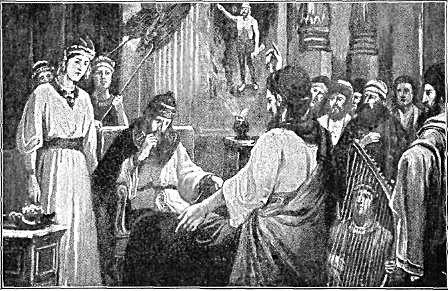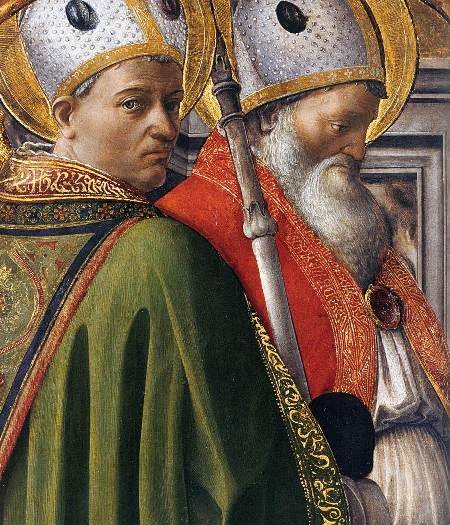The destruction of a large part of the Assyrian army by God before Jerusalem in 701 B.C. only provided a brief respite for the incorrigible city. It refused to take advantage of God’s mercy and continued in its sinful ways with the predictable results.
By the final years of the seventh century, the Neo-Babylonians under Nebuchadnezzar – famous for his Hanging Gardens – had replaced the Assyrians as God’s instrument of anger. The latter had been punished for its own transgressions as Isaias had predicted.
The Prophet Daniel
The Babylonian king began his campaign against Jerusalem by taking hostages in 605 including Daniel and then thousands more among the Jewish nobility eight years later. The final assault came in 587 when Nebuchadnezzar put the city to the torch and leveled the Temple. The remnant of about 20,000, hungry, desolate and parched, marched in chains under the hot, desert sun to Babylon.

The Prophet Daniel interprets Nebuchadnezzar’s dream.
Much like Joseph a thousand years before in Egypt, Daniel worked himself into a favored, influential position in the opulent city on the Euphrates.
This allowed him to record several visions that formed a basis for subsequent apocalyptic literature which became a Christian interpretation of history and part of God’s revelation to man.
The other major prophets dealt primarily with only the problems of the Middle East, but Daniel enlarged the template to include a view of universal history. In one famous vision, Daniel saw a colossal statue made of successive layers from top to bottom of gold, silver, brass, and a combination of iron and clay, representing four empires.

The Prophet Daniel with lion.
This succession of empires gives us a broad outline of the last centuries leading to the birth of Jesus Christ.
Then a stone cut from a mountain without hands crushed the fourfold image of world empires and grew until it filled the whole world. Daniel then explained that God will “set up a kingdom that shall never be destroyed…and itself shall stand forever.” (Dan. 2:44)
City of God
Saint Augustine as anyone familiar with his Confessions knows combined a brilliant mind that always sought the truth with a sensual nature addicted to immoral pleasures in a classic example of personal, internal conflict. His quest for the truth led him to reject the wild speculations of the gnostic sect of the Manicheans to which he had formally adhered as a young philosophy student and teacher.
Through the sermons of Saint Ambrose, another great Church Father of the West, he came to grasp, while at Milan, the spiritual reality of God who was the source of being and intelligence.
While studying Saint Paul’s epistle to the Romans, he received an extraordinary grace to lead a life of chastity and sacrifice and was subsequently baptized by Saint Ambrose at the age of 32. Within a decade he was consecrated Bishop of Hippo, the second largest city after Carthage, and began his outstanding career as theologian and historian which reached its apex in one of the greatest works of Catholic literature, The City of God.
The Western Roman Empire began to collapse during the last decade of the fourth century as barbarians poured through the frontier defenses. In 410 Alaric, a Visigoth chieftain originally trained by the Romans, invaded Italy and for three days ravaged the city of Rome.
While the civilized world sobbed and lamented, Augustine saw the hand of God. The Christians, many of whom were still dominated by their pagan education and worldly impulses, lost their confidence in Divine Providence and the pagans blamed the catastrophe on the abandonment of pagan ritual.
To answer these complaints and to illustrate the relationship between the temporal and spiritual orders, the Bishop of Hippo undertook the arduous, thirteen year task of writing The City of God.
Saint Augustine with Saint Ambrose. The struggle between the City of God and the City
of Man constitutes the substance of history.
Using the testimony of pagan authors, Augustine argues that irreligion and immorality were the true cause of Rome’s downfall. Kingdoms which were created by God became evil when they departed from His holy will.
Thus the brilliant saint gives us a synthesis of universal history in light of Christian principles, from the act of creation to God’s intervention in history through a small, uncultured Semitic people to the coming of God-man which was the turning point of history.
When the great power of God was brought to earth in the person of Christ and His teaching, what was the response of those whom He created?
It fell into two categories based on the object of their love: the heavenly city or, more properly, a society built up by the love of God to the contempt of self, and the earthly society built up by the love of self to the contempt of God.
Man has the power to choose his own good: either by subordinating his will to the divine order, or to the satisfaction of his own desires and making himself the center of the universe. The struggle between these two societies constitutes the substance of history.
Written by Jeremias Wells



No comments:
Post a Comment